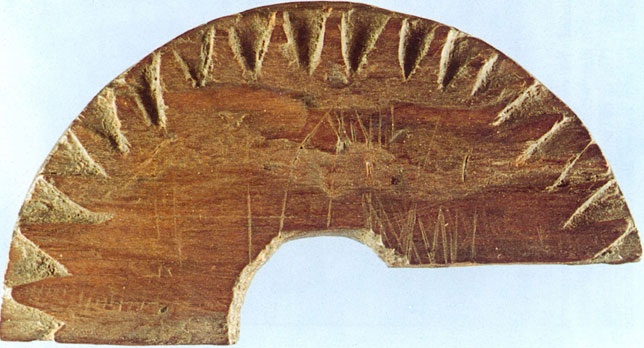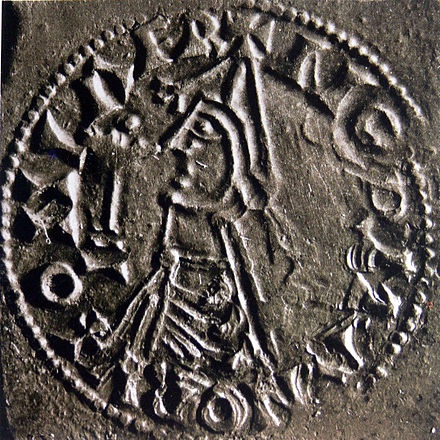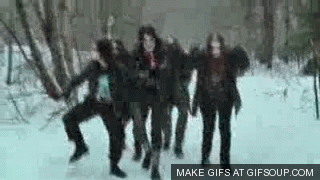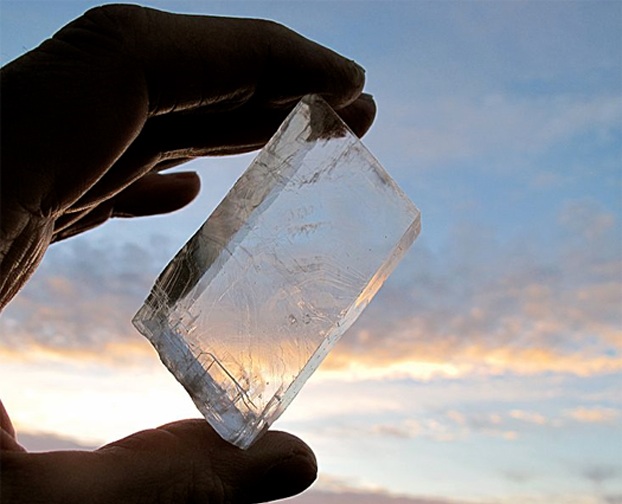It looks like you're using an Ad Blocker.
Please white-list or disable AboveTopSecret.com in your ad-blocking tool.
Thank you.
Some features of ATS will be disabled while you continue to use an ad-blocker.
23
share:
Vikings are best known for invading foreign lands, battles, shield walls and pillaging, all around scary folks. They are also known for their
navigation skills and this twilight compass is a testament to that. Not only did they rule in battle, Vikings could successfully sail in the sea after
dark using the Uunartoq disc, a combination of sunstones and a special disc that gave the Vikings a navigation tool comparable to a modern magnetic
pocket compasses. After sunset, right around the spring equinox the compass could have functioned for almost an hour after dark.
While no sunstones were found with this disc, written and oral medieval history suggests that sunstones would have been available to the Vikings, while others suggest that it is simply a decorative object.

In 1948 the Uunartoq disc was discovered in an 11th century Greenland convent and is thought to have been used as a compass by Vikings as they traversed the ocean. (Photo: Proceedings of the Royal Society)
sunstones guided vikings, even after sunset
While no sunstones have been discovered in Viking archaeological sites, a sunstone found in a British shipwreck, near the Channel Islands, could prove they are more than folklore.

Researchers say this crystal found at the Alderney shipwreck near the Channel Islands could prove fabled Viking sunstones really did exist. Credit: Alderney Museum

coin of Olaf dated from 1023-1028
first evidence of Viking sunstone
While no sunstones were found with this disc, written and oral medieval history suggests that sunstones would have been available to the Vikings, while others suggest that it is simply a decorative object.

In 1948 the Uunartoq disc was discovered in an 11th century Greenland convent and is thought to have been used as a compass by Vikings as they traversed the ocean. (Photo: Proceedings of the Royal Society)
Often regarded as ruthless robbers, the Vikings were also impressive mariners capable of traversing the North Atlantic along a nearly straight line. Now, new interpretations of a medieval compass suggest the sea robbers may have skillfully used the sun to operate the compass even when the sun had set below the horizon.
The remains of the supposed compass — known as the Uunartoq disc— were found in Greenland in 1948 in an 11th-century convent. Though some researchers originally argued it was simply a decorative object, other researchers have suggested the disc was an important navigational tool that the Vikings would have used in their roughly 1,600-mile-long (2,500 kilometers) trek from Norway to Greenland.
Though only half of the wooden disc remains, it is estimated to have been roughly 2.8 inches (7 centimeters) in diameter with a now-lost central pin that would have cast a shadow from the sun indicative of a cardinal direction. [Images: Viking Twilight Compass Helps Navigate North Atlantic]
Researchers based at Eötvös Loránd University in Hungary have studied the fragment in detail. They concluded that although the disc could have functioned as a single entity, it was more likely used in conjunction with other tools — including a pair of crystals and a flat, wooden slab — to help navigate when the sun was low in the sky or even below the horizon.
"When the sun is low above the horizon, even the shadow of a small item can fall off the board, and such situations are frequent in the northern seas," said study co-author Balázs Bernáth.
Bernáth and colleagues think that, to help solve this long-shadow problem, the Vikings may have used a low-lying, domed object in the middle of the compass to create a wider, shorter shadow than a more typical sundial spike would. A wide hole within the center of the disk — previously interpreted as a place to grip the compass — could have served as a holding spot for this so-called central gnomon, the team suggests.
The researchers think that, to locate the sun after sunset, the Vikings could have used a pair of crystals known as sunstones, which are calcite stones that produce patterns when they're exposed to the polarization of UV rays within sunlight. When the crystals are held up to the sky, the orientation of these patterns cast within the stone can help pinpoint the position of the sun below the horizon.
Once the Vikings had determined the position of the hidden sun, they could have used a specially designed wooden slab called a shadow stick to simulate the shadow of the gnomon based on the angle at which the hidden sun would hit it. The location of the outer edge of that imaginary shadow could then have been used to determine their cardinal direction.
sunstones guided vikings, even after sunset
While no sunstones have been discovered in Viking archaeological sites, a sunstone found in a British shipwreck, near the Channel Islands, could prove they are more than folklore.

Researchers say this crystal found at the Alderney shipwreck near the Channel Islands could prove fabled Viking sunstones really did exist. Credit: Alderney Museum
Ancient lore has suggested that the Vikings used special crystals to find their way under less-than-sunny skies. Though none of these so-called "sunstones" have ever been found at Viking archaeological sites, a crystal uncovered in a British shipwreck could help prove they did indeed exist.
The crystal was found among the wreckage of the Alderney, an Elizabethan warship that sank near the Channel Islands in 1592. The stone was discovered less than 3 feet (1 meter) from a pair of navigation dividers, suggesting it may have been kept with the ship's other navigational tools, according to the research team headed by scientists at the University of Rennes in France.
A chemical analysis confirmed that the stone was Icelandic Spar, or calcite crystal, believed to be the Vikings' mineral of choice for their fabled sunstones, mentioned in the 13th-century Viking saga of Saint Olaf.

coin of Olaf dated from 1023-1028
No such crystals have been found yet at Viking sites. The team notes that archaeologists are unlikely to find complete crystals as part of a group of grave goods, since the Vikings often cremated their dead.
But recent excavations turned up the first calcite fragment at a Viking settlement, "proving some people in the Viking Age were employing Iceland spar crystals," the researchers wrote.
first evidence of Viking sunstone
edit on 28-3-2014 by Jennyfrenzy because: (no reason given)
reply to post by Jennyfrenzy
I am pretty sure I heard of their use of sunstones either from my father or in school when I was a kid, but it was only recently since I started watching the show Vikings had the story been refreshed in my mind. I didn't know they could be used into the night though. That is pretty interesting.
I think I will ick some up next time I get the chance to mess with.
S&F
I am pretty sure I heard of their use of sunstones either from my father or in school when I was a kid, but it was only recently since I started watching the show Vikings had the story been refreshed in my mind. I didn't know they could be used into the night though. That is pretty interesting.
I think I will ick some up next time I get the chance to mess with.
S&F
Interesting read JF. Thanks for sharing!
This form of technology would most certainty give the Vikings a great tactical advantage for their coastal raiding parties.
Would like to see some more info on topic come to light!
This form of technology would most certainty give the Vikings a great tactical advantage for their coastal raiding parties.
Would like to see some more info on topic come to light!
We were also incredibly good looking poets. Just saying...
Established trade routes from Europe to the middle east, essentially created Russia (sorry about that), had laws against slavery (contrary to popular belief), spanked the English and the French at the same time, and found the new world while Chris Columbus was a gleam in his great great great great grand daddies eye.
Now we make cheap furniture and black metal. gg Christianity, gg.


Established trade routes from Europe to the middle east, essentially created Russia (sorry about that), had laws against slavery (contrary to popular belief), spanked the English and the French at the same time, and found the new world while Chris Columbus was a gleam in his great great great great grand daddies eye.
Now we make cheap furniture and black metal. gg Christianity, gg.


edit on 28-3-2014 by DeadSeraph because: (no reason given)
Actually they did find a fragment of a sunstone where they found the wooden "sunclock".
I tried to find the article that mention it, but failed, all i know is that it's a danish article.
I also remember a group of Hungariens testing if Wikings could have used a sunstone to navigate with , and they came up with it worked very well. They got the idea from airplanes flying around the Northpole where compasses is not to be trusted, they use a speciel optical navigating tool that uses a crystal to position the sun.
I tried to find the article that mention it, but failed, all i know is that it's a danish article.
I also remember a group of Hungariens testing if Wikings could have used a sunstone to navigate with , and they came up with it worked very well. They got the idea from airplanes flying around the Northpole where compasses is not to be trusted, they use a speciel optical navigating tool that uses a crystal to position the sun.
edit on 28-3-2014 by Mianeye because: (no reason given)
Weren't the Vikings also the ones that had those crazy accurate cut lenses? Or are those the same as sunstones?
reply to post by Mianeye
Thanks for the info! I'll have check it out
reply to post by Malynn
Pretty sure that was the sunstone

Thanks for the info! I'll have check it out
reply to post by Malynn
Pretty sure that was the sunstone

reply to post by Jennyfrenzy
In a thread a year or so back I was discussing the sunstone,
and I mentioned that I had read it could help the Vikings to navigate even when the sun had dipped over the horizon-
I was told by someone that it couldn't do that,although it could help you to see where the sun was in cloudy weather,thus giving you accurate navigation.
I reckon it would work for a very short time after sunset maybe,just hinting at the glow of where the sun had set.
Its a common quartz type stone I think,calcite or something similar if I remember correctly.
The sort you find on modern graves as whiteish stone chips-they can be struck together in the dark to get a flash-its not a spark like you get with flint,but an x ray flash,I know- sounds mad but I think its for real.Try it.Its not harmful,you can do the same with sellotape,by ripping off a long strip .(Has to be total dark to see the flash.)
Sorry I digress...
In a thread a year or so back I was discussing the sunstone,
and I mentioned that I had read it could help the Vikings to navigate even when the sun had dipped over the horizon-
I was told by someone that it couldn't do that,although it could help you to see where the sun was in cloudy weather,thus giving you accurate navigation.
I reckon it would work for a very short time after sunset maybe,just hinting at the glow of where the sun had set.
Its a common quartz type stone I think,calcite or something similar if I remember correctly.
The sort you find on modern graves as whiteish stone chips-they can be struck together in the dark to get a flash-its not a spark like you get with flint,but an x ray flash,I know- sounds mad but I think its for real.Try it.Its not harmful,you can do the same with sellotape,by ripping off a long strip .(Has to be total dark to see the flash.)
Sorry I digress...
reply to post by Jennyfrenzy
The ones I meant were round/spherical in nature. I will see if I can find some info.
The ones I meant were round/spherical in nature. I will see if I can find some info.
new topics
-
A Warning to America: 25 Ways the US is Being Destroyed
New World Order: 2 hours ago -
President BIDEN's FBI Raided Donald Trump's Florida Home for OBAMA-NORTH KOREA Documents.
Political Conspiracies: 7 hours ago -
Maestro Benedetto
Literature: 9 hours ago -
Is AI Better Than the Hollywood Elite?
Movies: 9 hours ago
top topics
-
President BIDEN's FBI Raided Donald Trump's Florida Home for OBAMA-NORTH KOREA Documents.
Political Conspiracies: 7 hours ago, 27 flags -
Weinstein's conviction overturned
Mainstream News: 17 hours ago, 8 flags -
Gaza Terrorists Attack US Humanitarian Pier During Construction
Middle East Issues: 14 hours ago, 8 flags -
Massachusetts Drag Queen Leads Young Kids in Free Palestine Chant
Social Issues and Civil Unrest: 16 hours ago, 7 flags -
Las Vegas UFO Spotting Teen Traumatized by Demon Creature in Backyard
Aliens and UFOs: 12 hours ago, 6 flags -
A Warning to America: 25 Ways the US is Being Destroyed
New World Order: 2 hours ago, 5 flags -
Meadows, Giuliani Among 11 Indicted in Arizona in Latest 2020 Election Subversion Case
Mainstream News: 15 hours ago, 5 flags -
2024 Pigeon Forge Rod Run - On the Strip (Video made for you)
Automotive Discussion: 13 hours ago, 4 flags -
Is AI Better Than the Hollywood Elite?
Movies: 9 hours ago, 3 flags -
Maestro Benedetto
Literature: 9 hours ago, 1 flags
active topics
-
University of Texas Instantly Shuts Down Anti Israel Protests
Education and Media • 266 • : SchrodingersRat -
New whistleblower Jason Sands speaks on Twitter Spaces last night.
Aliens and UFOs • 66 • : baablacksheep1 -
Gaza Terrorists Attack US Humanitarian Pier During Construction
Middle East Issues • 31 • : 5thHead -
HORRIBLE !! Russian Soldier Drinking Own Urine To Survive In Battle
World War Three • 50 • : F2d5thCavv2 -
Russia Ukraine Update Thread - part 3
World War Three • 5732 • : F2d5thCavv2 -
The Acronym Game .. Pt.3
General Chit Chat • 7751 • : F2d5thCavv2 -
Salvador Dali's Moustaches
People • 28 • : zosimov -
Is AI Better Than the Hollywood Elite?
Movies • 17 • : ThePsycheaux -
The best Rice dish i've ever tasted... Kimchi Rice
Food and Cooking • 26 • : lamhaocc -
A Warning to America: 25 Ways the US is Being Destroyed
New World Order • 1 • : 727Sky
23
